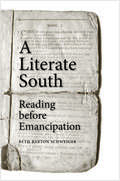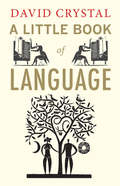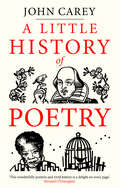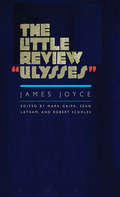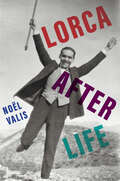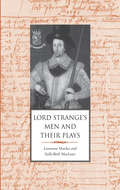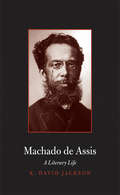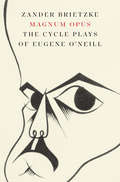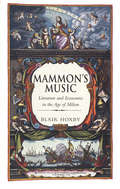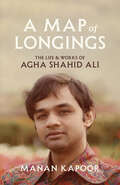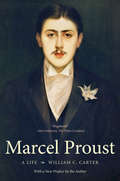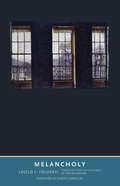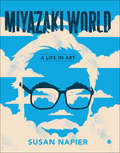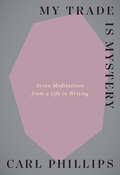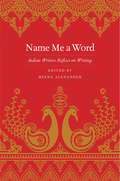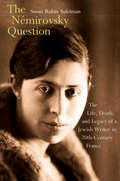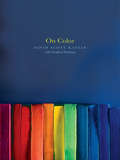- Table View
- List View
A Literate South: Reading before Emancipation
by Beth Barton SchweigerA provocative examination of literacy in the American South before emancipation, countering the long-standing stereotype of the South’s oral tradition Schweiger complicates our understanding of literacy in the American South in the decades just prior to the Civil War by showing that rural people had access to a remarkable variety of things to read. Drawing on the writings of four young women who lived in the Blue Ridge Mountains, Schweiger shows how free and enslaved people learned to read, and that they wrote and spoke poems, songs, stories, and religious doctrines that were circulated by speech and in print. The assumption that slavery and reading are incompatible—which has its origins in the eighteenth century—has obscured the rich literate tradition at the heart of Southern and American culture.
A Little Book of Language (Little Histories)
by David CrystalWith a language disappearing every two weeks and neologisms springing up almost daily, an understanding of the origins and currency of language has never seemed more relevant. In this charming volume, a narrative history written explicitly for a young audience, expert linguist David Crystal proves why the story of language deserves retelling.From the first words of an infant to the peculiar modern dialect of text messaging, A Little Book of Language ranges widely, revealing language’s myriad intricacies and quirks. In animated fashion, Crystal sheds light on the development of unique linguistic styles, the origins of obscure accents, and the search for the first written word. He discusses the plight of endangered languages, as well as successful cases of linguistic revitalization. Much more than a history, Crystal’s work looks forward to the future of language, exploring the effect of technology on our day-to-day reading, writing, and speech. Through enlightening tables, diagrams, and quizzes, as well as Crystal’s avuncular and entertaining style, A Little Book of Language will reveal the story of language to be a captivating tale for all ages.
A Little History of Poetry (Little Histories)
by John CareyA vital, engaging, and hugely enjoyable guide to poetry, from ancient times to the present, by one of our greatest champions of literature What is poetry? If music is sound organized in a particular way, poetry is a way of organizing language. It is language made special so that it will be remembered and valued. It does not always work—over the centuries countless thousands of poems have been forgotten. This little history is about some that have not. John Carey tells the stories behind the world’s greatest poems, from the oldest surviving one written nearly four thousand years ago to those being written today. Carey looks at poets whose works shape our views of the world, such as Dante, Chaucer, Shakespeare, Whitman, and Yeats. He also looks at more recent poets, like Derek Walcott, Marianne Moore, and Maya Angelou, who have started to question what makes a poem "great" in the first place. This little history shines a light on the richness and variation of the world’s poems—and the elusive quality that makes them all the more enticing.
The Little Review "Ulysses"
by James Joyce Mark Gaipa Sean Latham Robert ScholesJames Joyce’s Ulysses first appeared in print in the pages of an American avant-garde magazine, The Little Review, between 1918 and 1920. The novel many consider to be the most important literary work of the twentieth century was, at the time, deemed obscene and scandalous, resulting in the eventual seizure of The Little Review and the placing of a legal ban on Joyce’s masterwork that would not be lifted in the United States until 1933. For the first time, The Little Review “Ulysses” brings together the serial installments of Ulysses to create a new edition of the novel, enabling teachers, students, scholars, and general readers to see how one of the previous century’s most daring and influential prose narratives evolved, and how it was initially introduced to an audience who recognized its radical potential to transform Western literature. This unique and essential publication also includes essays and illustrations designed to help readers understand the rich contexts in which Ulysses first appeared and trace the complex changes Joyce introduced after it was banned.
Lorca After Life
by Noel ValisA reflection on Federico García Lorca’s life, his haunting death, and the fame that reinvigorated the marvelous in the modern world “A galaxy of critical insights into the cultural shock waves circling and crisscrossing Lorca’s execution and his unknown resting place, there is not a single book on Lorca like this one.”—Andrés Zamora, Vanderbilt University There is something fundamentally unfinished about the life and work of Federico García Lorca (1898–1936), and not simply because his life ended abruptly. Noël Valis reveals how this quality gives shape to the ways in which he has been continuously re-imagined since his death. Lorca’s execution at the start of the Spanish Civil War was not only horrific but transformative, setting in motion many of the poet’s afterlives. He is intimately tied to both an individual and a collective identity, as the people’s poet, a gay icon, and fabled member of a dead poets’ society. The specter of his violent death continues to haunt everything connected to Lorca, fueling the desire to fill in the gaps in the poet’s biography.
Lord Strange's Men and Their Plays
by Prof. Lawrence Manley Prof. Sally-Beth MacLeanFor a brief period in the late Elizabethan Era an innovative company of players dominated the London stage. A fellowship of dedicated thespians, Lord Strange’s Men established their reputation by concentrating on “modern matter” performed in a spectacular style, exploring new modes of impersonation, and deliberately courting controversy. Supported by their equally controversial patron, theater connoisseur and potential claimant to the English throne Ferdinando Stanley, the company included Edward Alleyn, considered the greatest actor of the age, as well as George Bryan, Thomas Pope, Augustine Phillips, William Kemp, and John Hemings, who later joined William Shakespeare and Richard Burbage in the Lord Chamberlain’s Men. Though their theatrical reign was relatively short lived, Lord Strange’s Men helped to define the dramaturgy of the period, performing the plays of Shakespeare, Christopher Marlowe, Thomas Kyd, and others with their own distinctive flourish. Lawrence Manley and Sally-Beth MacLean offer the first complete account of the troupe and its enormous influence on Elizabethan theater. Seamlessly blending theater history and literary criticism, the authors paint a lively portrait of a unique community of performing artists, their intellectual ambitions and theatrical innovations, their business practices, and their fearless engagements with the politics and religion of their time.
Machado de Assis: A Literary Life (Major Figures in Spanish and Latin American Literature and the Arts)
by K. David JacksonNovelist, poet, playwright, and short story writer Joaquim Maria Machado de Assis (1839–1908) is widely regarded as Brazil’s greatest writer, although his work is still too little read outside his native country. In this first comprehensive English-language examination of Machado since Helen Caldwell’s seminal 1970 study, K. David Jackson reveals Machado de Assis as an important world author, one of the inventors of literary modernism whose writings profoundly influenced some of the most celebrated authors of the twentieth century, including José Saramago, Carlos Fuentes, and Donald Barthelme. Jackson introduces a hitherto unknown Machado de Assis to readers, illuminating the remarkable life, work, and legacy of the genius whom Susan Sontag called “the greatest writer ever produced in Latin America” and whom Allen Ginsberg hailed as “another Kafka.” Philip Roth has said of him that “like Beckett, he is ironic about suffering.” And Harold Bloom has remarked of Machado that “he’s funny as hell.”
Magnum Opus: The Cycle Plays of Eugene O'Neill
by Zander BrietzkeAn original and provocative analysis of Eugene O'Neill's unfinished cycle play project From 1935 to 1939, Eugene O'Neill worked on a series of plays that would trace the history of an American family through several generations. He completed just two of the proposed eleven plays—A Touch of the Poet and More Stately Mansions—which Zander Brietzke argues represent the core of the entire cycle. Combining archival research, literary analysis, and theatrical imagination, Magnum Opus invites an audience to see this unusual and exciting epic as a historical drama of our time.
Mammon’s Music: Literature and Economics in the Age of Milton
by Professor Blair HoxbyThe commercial revolution of the seventeenth century deeply changed English culture. In this ambitious book, Blair Hoxby explores what that economic transformation meant to the century’s greatest poet, John Milton, and to the broader literary tradition in which he worked. Hoxby places Milton’s work-as well as the writings of contemporary reformers like the Levellers, poets like John Dryden, and political economists like Sir William Petty-within the framework of England’s economic history between 1601 and 1724. Literary history swerved in this period, Hoxby demonstrates, as a burgeoning economic discourse pressed authors to reimagine ideas about self, community, and empire. Hoxby shows that, contrary to commonly held views, Milton was a sophisticated economic thinker. Close readings of Milton’s prose and verse reveal the importance of economic ideas in a wide range of his most famous writings, from Areopagitica to Samson Agonistes to Paradise Lost.
A Map of Longings: The Life and Works of Agha Shahid Ali
by Manan KapoorThe beautifully written first biography of one of the world’s finest twentieth-century poets Agha Shahid Ali (1949–2001) was one of the most celebrated American poets of the latter twentieth century, and his works have touched millions of lives around the world. Traversing multiple geographies, cultures, religions, and traditions, he mapped the varied landscapes of the Indian subcontinent and the United States. In this biography, Manan Kapoor narrates Shahid’s evolution, following in the footsteps of the “Beloved Witness” from Kashmir and New Delhi to the American Southwest and Massachusetts. He charts Shahid’s friendships with literary figures such as James Merrill, Salman Rushdie, and Edward Said; explores how Shahid responded to events around the world, including the partition of the Indian subcontinent and the AIDS epidemic in America; and draws on unpublished materials and in-depth interviews to reveal the experiences and relationships that informed his poetry. Hailed upon its release in India as “lush” and “poetic,” A Map of Longings is the story of an extraordinary poet, the works he left behind, and the legacy of his singular poetic vision.
Marcel Proust: A Life, with a New Preface by the Author (Henry McBride Series in Modernism and Modernity)
by William C. CarterReissued with a new preface to commemorate the first publication of À la recherche du temps perdu one hundred years ago, Marcel Proust portrays in abundant detail the extraordinary life and times of one of the greatest literary voices of the twentieth century. “An impeccably researched and well-paced narrative that brings vividly and credibly to life not only the writer himself but also the changing world he knew.”—Roger Pearson, New York Times Book Review “William C. Carter is Proust’s definitive biographer.”—Harold Bloom Named a Notable Book of 2000 by the New York Times Book Review
Melancholy (The Margellos World Republic of Letters)
by László F. Földényi (Foldenyi)Alberto Manguel praises the Hungarian writer László Földényi as “one of the most brilliant essayists of our time.” Földényi’s extraordinary Melancholy, with its profusion of literary, ecclesiastical, artistic, and historical insights, gives proof to such praise. His book, part history of the term melancholy and part analysis of the melancholic disposition, explores many centuries to explore melancholy’s ambiguities. Along the way Földényi discovers the unrecognized role melancholy may play as a source of energy and creativity in a well-examined life. Földényi begins with a tour of the history of the word melancholy, from ancient Greece to the medieval era, the Renaissance, and modern times. He finds the meaning of melancholy has always been ambiguous, even paradoxical. In our own times it may be regarded either as a psychic illness or a mood familiar to everyone. The author analyzes the complexities of melancholy and concludes that its dual nature reflects the inherent tension of birth and mortality. To understand the melancholic disposition is to find entry to some of the deepest questions one’s life. This distinguished translation brings Földényi’s work directly to English-language readers for the first time.
Miyazakiworld: A Life in Art
by Susan NapierThe story of filmmaker Hayao Miyazaki's life and work, including his significant impact on Japan and the world A thirtieth†‘century toxic jungle, a bathhouse for tired gods, a red†‘haired fish girl, and a furry woodland spirit—what do these have in common? They all spring from the mind of Hayao Miyazaki, one of the greatest living animators, known worldwide for films such as My Neighbor Totoro, Princess Mononoke, Spirited Away, Howl’s Moving Castle, and The Wind Rises. Japanese culture and animation scholar Susan Napier explores the life and art of this extraordinary Japanese filmmaker to provide a definitive account of his oeuvre. Napier insightfully illuminates the multiple themes crisscrossing his work, from empowered women to environmental nightmares to utopian dreams, creating an unforgettable portrait of a man whose art challenged Hollywood dominance and ushered in a new chapter of global popular culture.
My Trade Is Mystery: Seven Meditations from a Life in Writing
by Carl PhillipsAn invaluable companion for writers at every stage of their journey to make the writing life a more complex and cooperative venture In this intimate and eloquent meditation, the award-winning poet Carl Phillips shares lessons he has learned about what he calls an “apprenticeship to what can never fully be mastered,” through forty years of teaching and mentoring emerging writers. He weaves together his experiences as a poet and prose writer with discussions of underexplored elements of the writing life, including ambition, stamina, silence, politics, practice, audience, and community. In the tradition of Anne Lamott’s Bird by Bird, Rainer Maria Rilke’s Letters to a Young Poet, and Marcus Aurelius’s Meditations, this is an invaluable companion for writers at every stage of their journey. Phillips’s book serves as a partner in speculation and an invitation to embrace mystery.
Name Me a Word: Indian Writers Reflect on Writing
by Meena AlexanderA wide-ranging anthology of twentieth-century and contemporary writing from India and the Indian diaspora, curated by a distinguished scholar and poet Internationally renowned scholar, poet, and essayist Meena Alexander brings together leading twentieth- and twenty-first-century voices from India and the diaspora in this anthology. Contributors include English-language luminaries such as R. K. Narayan, Salman Rushdie, and Arundhati Roy and powerful writers in Indian languages such as U. R. Ananthamurthy, Mahasweta Devi, and Lalithambika Antherjanam. This book will make a thoughtful gift for poetry and fiction enthusiasts and fans of Indian literature, as well as an ideal volume for academics introducing writers from the subcontinent.
The Némirovsky Question: The Life, Death, and Legacy of a Jewish Writer in Twentieth-Century France
by Susan Rubin SuleimanA fascinating look into the life and work of controversial French novelist Irène Némirovsky Irène Némirovsky succeeded in creating a brilliant career as a novelist in the 1930s, only to have her life cut short: a “foreign Jew” in France, she was deported in 1942 and died in Auschwitz. But her two young daughters survived, and as adults they brought their mother back to life. In 2004, Suite française, Némirovsky’s posthumous novel, became an international best seller; some critics, however, condemned her as a “self-hating Jew” whose earlier works were rife with anti-Semitic stereotypes. Informed by personal interviews with Némirovsky’s descendants and others, as well as by extensive archival research, this wide-ranging intellectual biography situates Némirovsky in the literary and political climate of interwar France and recounts, for the first time, the postwar lives of her daughters. Némirovsky's Jewish works, Suleiman argues, should be read as explorations of the conflicted identities that shaped the lives of secular Jews in twentieth-century Europe and beyond.
The New Science: The First New Science (Cambridge Texts In The History Of Political Thought Ser.)
by Giambattista VicoA fresh translation of The New Science, with detailed footnotes that will help both the scholar and the new reader navigate Vico’s masterpiece†‹The New Science is the major work of Italian philosopher Giambattista Vico. First published in 1725 and revised in 1730 and 1744, it calls for a reinterpretation of human civilization by tracing the stages of historical development shared by all societies. Almost unknown during his lifetime, the work had a profound influence on later thinkers, from Montesquieu and Marx to Joyce and Gadamer. This edition offers a fresh translation and detailed annotations which enable the reader to track Vico’s multiple allusions to other texts. The introduction situates the work firmly within a contemporary context and newly establishes Vico as a thinker of modernity.
Novel Beginnings: Experiments in Eighteenth-Century English Fiction (Yale Guides to English Literature)
by Professor Patricia Meyer SpacksIn this study intended for general readers, eminent critic Patricia Meyer Spacks provides a fresh, engaging account of the early history of the English novel. Novel Beginnings departs from the traditional, narrow focus on the development of the realistic novel to emphasize the many kinds of experimentation that marked the genre in the eighteenth century before its conventions were firmly established in the nineteenth. Treating well-known works like Tom Jones and Tristram Shandy in conjunction with less familiar texts such as Sarah Fielding’s The Cry (a kind of hybrid novel and play) and Jane Barker’s A Patch-Work Screen for the Ladies (a novel of adventure replete with sentimental verse and numerous subnarratives), the book evokes the excitement of a multifaceted and unpredictable process of growth and change.Investigating fiction throughout the 1700s, Spacks delineates the individuality of specific texts while suggesting connections among novels. She sketches a wide range of forms and themes, including Providential narratives, psychological thrillers, romans à clef, sentimental parables, political allegories, Gothic romances, and many others. These multiple narrative experiments show the impossibility of thinking of eighteenth-century fiction simply as a precursor to the nineteenth-century novel, Spacks shows. Instead, the vast variety of engagements with the problems of creating fiction demonstrates that literary history-by no means inexorable-might have taken quite a different course.
The Object of Jewish Literature: A Material History
by Barbara E. MannA history of modern Jewish literature that explores our enduring attachment to the book as an object With the rise of digital media, the "death of the book” has been widely discussed. But the physical object of the book persists. Here, through the lens of materiality and objects, Barbara E. Mann tells a history of modern Jewish literature, from novels and poetry to graphic novels and artists’ books. Bringing contemporary work on secularism and design in conversation with literary history, she offers a new and distinctive frame for understanding how literary genres emerge. The long twentieth century, a period of tremendous physical upheaval and geographic movement, witnessed the production of a multilingual canon of writing by Jewish authors. Literature’s objecthood is felt not only in the physical qualities of books—bindings, covers, typography, illustrations—but also through the ways in which materiality itself became a practical foundation for literary expression.
Obsolete Objects in the Literary Imagination: Ruins, Relics, Rarities, Rubbish, Uninhabited Places, and Hidden Treasures
by Prof. Francesco OrlandoTranslated here into English for the first time is a monumental work of literary history and criticism comparable in scope and achievement to Eric Auerbach’s Mimesis. Italian critic Francesco Orlando explores Western literature’s obsession with outmoded and nonfunctional objects (ruins, obsolete machinery, broken things, trash, etc.). Combining the insights of psychoanalysis and literary-political history, Orlando traces this obsession to a turning point in history, at the end of eighteenth-century industrialization, when the functional becomes the dominant value of Western culture. Roaming through every genre and much of the history of Western literature, the author identifies distinct categories into which obsolete images can be classified and provides myriad examples. The function of literature, he concludes, is to remind us of what we have lost and what we are losing as we rush toward the future.
Of Solids and Surds: Notes for Noël Sturgeon, Marilyn Hacker, Josh Lukin, Mia Wolff, Bill Stribling, and Bob White (Why I Write)
by Samuel R DelanyIn the fourth volume in the Why I Write series, the iconic Samuel Delany remembers fifty years of writing and shaping the world of speculative fiction“Delany’s prismatic output is among the most significant, immense and innovative in American letters.”—Jordy Rosenberg, New York Times"He dispenses wisdom about craft—including the demanding revision process his dyslexia requires—but most moving are the moments when he sheds light on connections he has made with other readers and writers. . . . Delany’s fans are in for a treat."—Publishers Weekly, Starred Review Language is the way humans deal with past, present, and future possibilities, as well as the subset called the probable. This is where Samuel Delany finds his justification for the writing life. Since the 1960s, occurrences such as Sputnik, school desegregation, and the advent of AIDS have given Delany, as a gay man, as a black man, access to certain truths and facts he could write about, and the language—sometimes fiction, sometimes nonfiction—in which to present them. “We write,” Delany believes, “at the intersection of your experience and mine in a way, I hope, that allows recognition.&rdquo
Old English Literature: Critical Essays
by R. M. LiuzzaRecognizing the dramatic changes in Old English studies over the past generation, this up-to-date anthology gathers twenty-one outstanding contemporary critical writings on the prose and poetry of Anglo-Saxon England, from approximately the seventh through eleventh centuries. The contributors focus on texts most commonly read in introductory Old English courses while also engaging with larger issues of Anglo-Saxon history, culture, and scholarship. Their approaches vary widely, encompassing disciplines from linguistics to psychoanalysis.In an appealing introduction to the book, R. M. Liuzza presents an overview of Old English studies, the history of the scholarship, and major critical themes in the field. For both newcomers and more advanced scholars of Old English, these essays will provoke discussion, answer questions, provide background, and inspire an appreciation for the complexity and energy of Anglo-Saxon studies.
On Color
by David Kastan Stephen FarthingRanging from Homer to Picasso, and from the Iranian Revolution to The Wizard of Oz, this spirited and radiant book awakens us anew to the role of color in our lives Our lives are saturated by color. We live in a world of vivid colors, and color marks our psychological and social existence. But for all color’s inescapability, we don’t know much about it. Now authors David Scott Kastan and Stephen Farthing offer a fresh and imaginative exploration of one of the most intriguing and least understood aspects of everyday experience. Kastan and Farthing, a scholar and a painter, respectively, investigate color from numerous perspectives: literary, historical, cultural, anthropological, philosophical, art historical, political, and scientific. In ten lively and wide-ranging chapters, each devoted to a different color, they examine the various ways colors have shaped and continue to shape our social and moral imaginations. Each individual color becomes the focal point for a consideration of one of the extraordinary ways in which color appears and matters in our lives. Beautifully produced in full color, this book is a remarkably smart, entertaining, and fascinating guide to this elusive topic.
On Historical Distance (The Lewis Walpole Series in Eighteenth-C)
by Mark Salber PhillipsConceptions of distance are foundational to historical thought, but Mark Salber Phillips gives the idea new subtlety and meaning. He argues that distance is a matter not just of time and space but also of form, affect, ideology, and understanding. In this exceptionally wide-ranging study, Phillips examines Renaissance, Enlightenment, and contemporary histories, as well as a broad spectrum of historical genres—including local history, literary history, counter-factual fiction, history painting, and museology.“On Historical Distance is a fascinating and very important book that should be read by all historians. Beautifully written in elegant, economical and engaging prose, the book wears its considerable learning very lightly. A deeply original, challenging and thought-provoking study of the evolving history of history by one of our leading historians of historiography, this book should provoke a lively debate among historians and should be assigned as essential reading for classes on historical methods and historiography.”—John Marshall, John Hopkins University
On Parchment: Animals, Archives, and the Making of Culture from Herodotus to the Digital Age
by Bruce HolsingerA sweeping exploration of the shaping role of animal skins in written culture and human imagination over three millennia “Richly detailed and illustrated. . . . An engaging exploration of book history.”—Kirkus Reviews For centuries, premodern societies recorded and preserved much of their written cultures on parchment: the rendered skins of sheep, cows, goats, camels, deer, gazelles, and other creatures. These remains make up a significant portion of the era’s surviving historical record. In a study spanning three millennia and twenty languages, Bruce Holsinger explores this animal archive as it shaped the inheritance of the Euro-Mediterranean world, from the leather rolls of ancient Egypt to the Acts of Parliament in the United Kingdom. Holsinger discusses the making of parchment past and present, the nature of the medium as a biomolecular record of faunal life and environmental history, the knotty question of “uterine vellum,” and the imaginative role of parchment in the works of St. Augustine, William Shakespeare, and a range of Jewish rabbinic writers of the medieval era. Closely informed by the handicraft of contemporary makers, painters, and sculptors, the book draws on a vast array of sources—codices and scrolls, documents and ephemera, works of craft and art—that speak to the vitality of parchment across epochs and continents. At the center of On Parchment is the vexed relationship of human beings to the myriad slaughtered beasts whose remains make up this vast record: a relationship of dominion and compassion, of brutality and empathy.
